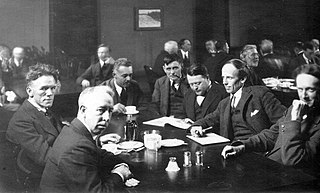
The Group of Seven, once known as the Algonquin School, was a group of Canadian landscape painters from 1920 to 1933, with "a like vision". It originally consisted of Franklin Carmichael (1890–1945), Lawren Harris (1885–1970), A. Y. Jackson (1882–1974), Frank Johnston (1888–1949), Arthur Lismer (1885–1969), J. E. H. MacDonald (1873–1932), and Frederick Varley (1881–1969). A. J. Casson (1898–1992) was invited to join in 1926, Edwin Holgate (1892–1977) became a member in 1930, and Lionel LeMoine FitzGerald (1890–1956) joined in 1932.

Australian art is any art made in or about Australia, or by Australians overseas, from prehistoric times to the present. This includes Aboriginal, Colonial, Landscape, Atelier, early-twentieth-century painters, print makers, photographers, and sculptors influenced by European modernism, Contemporary art. The visual arts have a long history in Australia, with evidence of Aboriginal art dating back at least 30,000 years. Australia has produced many notable artists of both Western and Indigenous Australian schools, including the late-19th-century Heidelberg School plein air painters, the Antipodeans, the Central Australian Hermannsburg School watercolourists, the Western Desert Art Movement and coeval examples of well-known High modernism and Postmodern art.
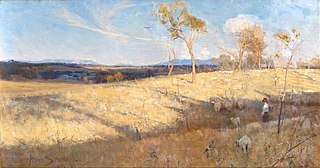
The Heidelberg School was an Australian art movement of the late 19th century. It has been described as Australian impressionism.

The Eureka Flag was flown at the Battle of the Eureka Stockade, which took place on 3 December 1854 at Ballarat in Victoria, Australia. It was the culmination of the 1851–1854 Eureka Rebellion on the Victorian goldfields. Gold miners protested the cost of mining permits, the officious way the colonial authorities enforced the system, and other grievances. An estimated crowd of over 10,000 demonstrators swore allegiance to the flag as a symbol of defiance at Bakery Hill on 29 November 1854. It was then flown over the Eureka Stockade during the battle that resulted in at least 27 deaths. Around 120 miners were arrested, and many others were badly wounded.
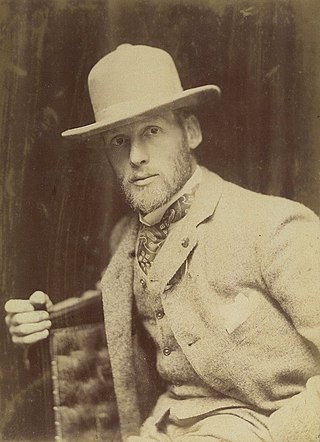
Thomas William Roberts was an English-born Australian artist and a key member of the Heidelberg School art movement, also known as Australian impressionism.

Sir Arthur Ernest Streeton was an Australian landscape painter and a leading member of the Heidelberg School, also known as Australian Impressionism.

The Box Hill artists' camp was a site in Box Hill, Victoria, Australia favoured by a group of plein air painters in the mid to late 1880s who later became associated with the Heidelberg School art movement, also known as Australian impressionism.
Ronald Warwick Radford is an Australian curator, who was the Director of the National Gallery of Australia (NGA) from 2004 until 2014. He was previously the Director of the Art Gallery of South Australia in Adelaide.
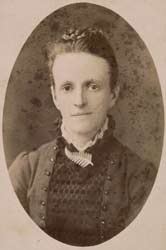
Jane Sutherland was an Australian landscape painter who was part of the pioneering plein-air movement in Australia, and a member of the Heidelberg School. Her advocacy to advance the professional standing of female artists during the late nineteenth century was also a notable achievement.

Mirka Madeleine Mora was a French-born Australian visual artist and cultural figure who contributed significantly to the development of Australian contemporary art. Her media included drawing, painting, sculpture and mosaic.
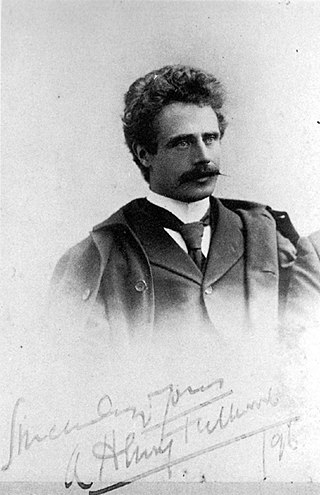
Albert Henry Fullwood was an Australian artist who made a significant contribution to art in Australia. He painted with Heidelberg School artists around Melbourne and moved with Tom Roberts and Arthur Streeton to live and paint at their camp in Sirius Cove, Sydney. Fullwood was the Australian official war artist to the 5th Division in the World War I.
Robert Jacks was an Australian painter, sculptor and printmaker.

Shearing the Rams is an 1890 painting by Australian artist Tom Roberts. It depicts sheep shearers plying their trade in a timber shearing shed. Distinctly Australian in character, the painting is a celebration of pastoral life and work, especially "strong, masculine labour", and recognises the role that the wool industry played in the development of the country.

Vaughan Murray Griffin was an Australian print maker and painter.
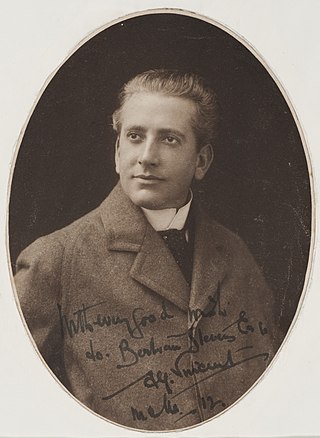
Alfred James Vincent was an Australian cartoonist born in Launceston, Tasmania.

The Golden Fleece, originally known as Shearing at Newstead, is an 1894 painting by the Australian artist Tom Roberts. The painting depicts sheep shearers plying their trade in a timber shearing shed at Newstead North, a sheep station near Inverell on the Northern Tablelands of New South Wales. The same shed is depicted in another of Roberts' works, Shearing Shed, Newstead (1894).

David Davies was an Australian artist who was associated with the Heidelberg School, the first significant Western art movement in Australia.

Artists' charcoal is charcoal used as a dry art medium. Both compressed charcoal and charcoal sticks are used. The marks it leaves behind on paper are much less permanent that with other media such as graphite, and so lines can easily be erased and blended. Charcoal can produce lines that are very light or intensely black. The dry medium can be applied to almost any surface from smooth to very coarse. Fixatives are used with charcoal drawings to solidify the position to prevent erasing or rubbing off of charcoal dusts.

Helen Elizabeth Ogilvie was a twentieth-century Australian artist and gallery director, cartoonist, painter, printmaker and craftworker, best known for her early linocuts and woodcuts, and her later oil paintings of vernacular colonial buildings.



















